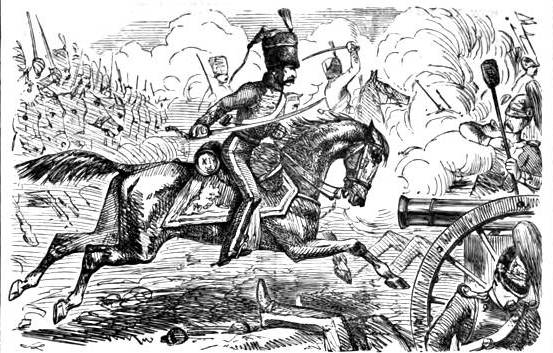I must confess, spoiled, wastrel, British aristocrats have long held interest for me, possibly from reading Flashman novels during my youth. A good example is George IV, Prinny to friends, a grotesquely obese, self indulgent sloth driven largely by gluttony, lust, and ego (he often fantasized aloud he’d been with Wellington at Waterloo. When he reminisced with the Iron Duke about the battle, his tactful reply was “So Your Majesty has often said.”).
That’s why I read Saul David’s biography of James Brudenell, the 7th Earl of Cardigan, with no little fascination. Cardigan is best known for having led the catastrophic Charge of the Light Brigade during the Crimean War, but already had a notorious reputation beforehand for innumerable quarrels, peccadilloes, and assorted scandals. Spoiled rotten from childhood (the only boy among six sisters), possessed of almost limitless wealth, prone to indulge every impulse, Cardigan was embroiled from youth in one wretched, damned piece of business after another, duels, divorces, serial adultery, and a suit for criminal connection (sex with another man’s wife). He figures prominently in Fraser’s Flashman At The Charge and other fictional depictions as the very picture of a domineering, self-indulgent, rude aristocrat. Trevor Howard gives perhaps the most vivid portrayal of this in Tony Richardson’s fact based 1968 film, The Charge of the Light Brigade.
A keen horseman and determined upon glory, Cardigan fixed on a career as a cavalryman and, in accordance with the prevailing system for acquiring rank in the British Army, purchased his commissions, often at a very high illegal premium above the stipulated price. He soon commanded one of the most distinguished cavalry regiments in the Army, the 11th Hussars (cavalry in the 19th Century had far more status and panache than lowly infantry). While he trained his troops hard and lavished money on equipment and uniforms from his own funds, his chief feature as a commander was his almost complete inability to get along with subordinate officers. One incident after another is described in which Cardigan embroiled himself in a bitter, personal quarrel with a junior officer, the most well known being the Black Bottle Affair, where Cardigan went ape because a subordinate ordered a bottle of Moselle at a formal regimental banquet. All these matters had to be kicked upstairs for resolution by the Army’s most senior officers. I know from my own limited military experience that COs absolutely hate trouble like this and it doesn’t take too many such incidents for them to form a distinctly adverse opinion of the officer causing all the ruckus. It must have taken all the Iron Duke’s legendary sang-froid to keep from tearing his hair out over Cardigan.
His one real chance to capture military glory, that elusive sprite, his ultimate goal, came with the Crimean War. I won’t extend this review to epic length by going into the complicated and confusing details of the Charge, but will simply note that the author gives a relatively straightforward, understandable account of the encounter, aided by maps and diagrams. His verdict on Cardigan’s behavior seems largely warranted to me as well: while he rode bravely with his men into the Valley of Death, he showed complete disinterest once he crossed the line of Russian guns, in fact, turned his horse and returned to the British lines with complete disregard for his men, a singularly gross act of dereliction of duty. Other unsavory details are provided, like his resting in luxury aboard his private steam yacht while his men slept in the open and their horses died of exposure and malnutrition.
Cardigan had the good fortune to return to England before all the Charge’s unappealing details had emerged. He had a brief moment in the sun, lionized and even received by Queen Victoria and her family, but the taint of his spoiled character surely intervened as it always would. Rivals and enemies, to include his own superior and brother-in-law, Lord Lucan, vigorously disputed in public his conduct during the Charge. The black cloud of suspicion and disrepute that had followed him all his adult life gathered again. Heedless, like the extremely self-centered man he was, Cardigan continued to go his own way, with enough energy in old age to create yet another scandal by marrying a woman half his age, who’d openly lived with Cardigan as his mistress previously. With Cardigan’s death, the last of the Brudenells, the title transferred to a collateral branch of the family.
The biographer does his best to be fair to his subject. Against charges of Cardigan being an upper class twit, he notes his good academic record during his brief school days and points out how he matured as a politician in the House of Lords. David also observes his frequent kindnesses to enlisted men and tenants, but also recognizes that this was considered noblesse oblige, the sort of obligation aristocrats were supposed to fulfill in Cardigan’s day. Despite these efforts at balance, I must say Cardigan still comes across as a thoroughly disagreeable sort of person, even making allowances for the different era and stratum he occupied from my own. And when it comes to the most important aspect of his life (by his own estimate), his military career, he was sadly lacking, the sort of superficial officer who worried more about sword knots and general turnout than unit cohesion and real combat effectiveness.
I recommend this book to anyone interested in the late Regency, early Victorian era in Great Britain and the Crimean War.




